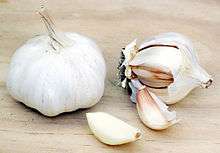Cookbook:Garlic
Cookbook | Recipes | Ingredients | Vegetable
| Herbs and Spices

Garlic is a pungently odoriferous member of the allium family (like onions and leeks). Garlic is generally used as a spice or a seasoning rather than as a vegetable due to its extremely strong flavour.
Garlic grows in large papery heads. A novice mistake is to massively overgarlic things by following instructions incorrectly. Remember that the large bulb of garlic you buy is NOT one 'clove'. The whole garlic is called a 'head' or 'knob'. Each small, individual segment of a garlic head is a clove.
Storing Garlic
Fresh garlic heads will keep for a long time as long as they are stored in a cool dark place. Do not keep them in the fridge or they will start to sprout and become bitter. They can be frozen without ill-effect, or simply stored in a dark cupboard away from moisture. Garlic braids should be hung to prevent crushing any of the cloves.
If you want to store the cloves individually and ready for use, the garlic must be either dried or processed. One good way to freeze prepared garlic is to crush or mince it in a food processor and mix it with a little water, then freeze it in ice cube trays so you can get cubes out as needed. Otherwise it can be frozen in olive oil, or frozen whole.
Never EVER store garlic in olive oil at room temperature or leave garlic in oil to sit on the counter. Because garlic is grown in the ground it is frequently contaminated with botulism spores, which are almost impossible to remove. These are harmless in their normal state, but because they are an anaerobic bacteria they will grow if the conditions are 'right' - i.e. submersed in oil and stored at room temperature. The spores can not grow in the cold, so freeze or refrigerate it, or better yet, store the garlic in vodka, wine or vinegar rather than oil.
Preparing Garlic
As a rule, the finer you chop or especially crush fresh garlic, the stronger the flavour will be. This is because the flavour compounds are released by breaking cell walls. It is usually crushed with the side of a knife (which also aids in peeling) or finely minced and used to season other dishes, especially Italian and French recipes. You can also use a garlic press, or bash it in a pestle and mortar with a bit of salt added to help reduce the garlic to a smooth paste. But it can also be used in slivers or as whole cloves, with a much milder result. Whole cloves are often roasted, and as they cook their flavour changes dramatically to become sweeter and less pungent.
One way to avoid the problem of how much garlic to use in a recipe and how to prepare it without ruining a chopping board and smelling up the kitchen is to buy it precrushed or prechopped in a jar. This type of preprepared garlic keeps basically forever in the fridge or freezer, and the garlic odour can not penetrate the glass. It is milder and often sweeter than fresh garlic because the 'garliciness' declines slightly with time. Rubbing your hands underwater on any stainless steel utensil will remove garlic odor from them.
Measurements
For cooking purposes, garlic is often measured in "cloves". A word of caution though: Depending on where you are in the world, an average clove can vary from 1 g to 6 g, not to mention the variations in taste. One should also consider the origin of the recipe.
North American manufacturers of pre-packaged minced garlic consider 2.5 g per clove, although one clove of fresh garlic can easily go up to 6 g in stores. One teaspoon of minced garlic would contain the equivalent of 2 cloves.
Recipes featuring garlic
Many recipes use garlic, but those listed below feature garlic as a major contributor to the recipe. For more recipes using garlic, click the "What links here" link at the bottom of the page.